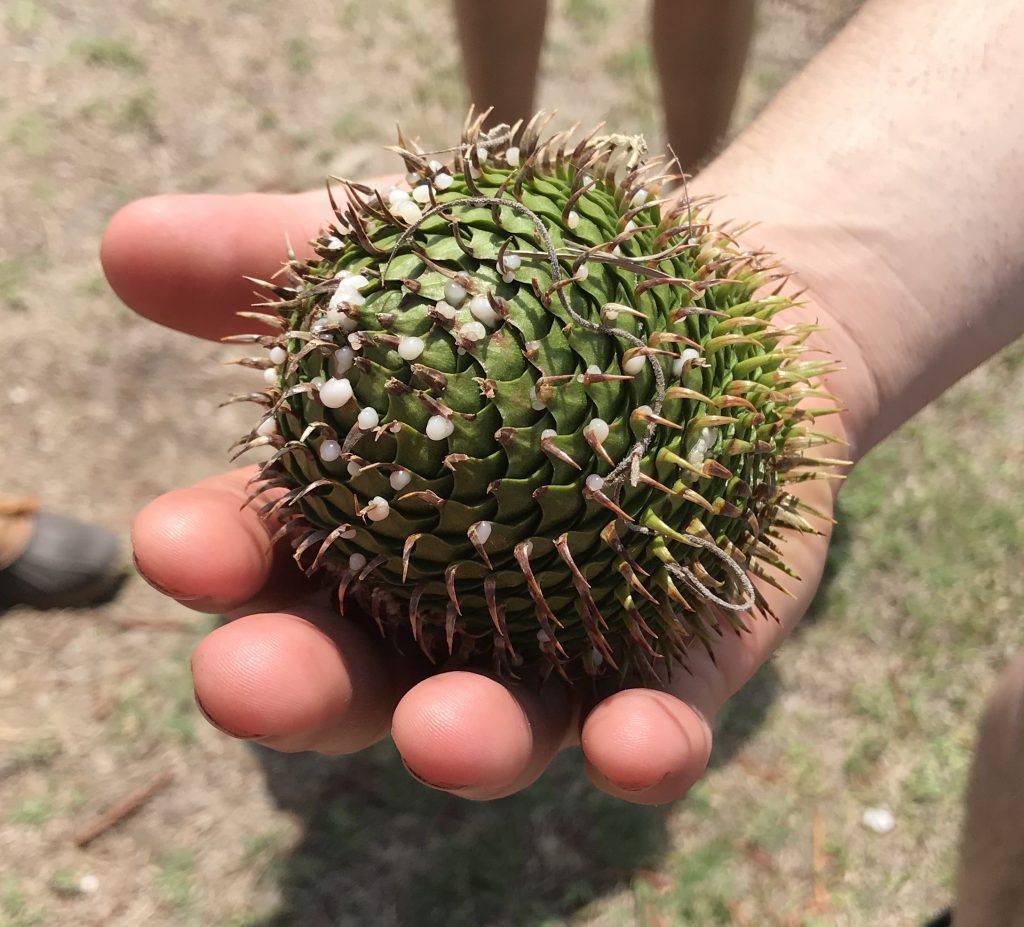
The unripe cone of the Norfolk Pine. Photo by Green Deane
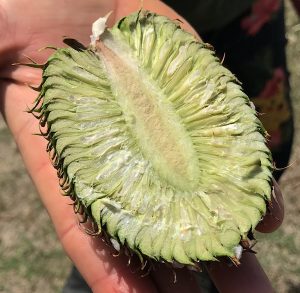
Undeveloped seeds in the Norfolk Pine cone. Photo by Green Deane
The Bunya Bunya and Norfolk Pine are closely related. Neither look good in landscaping though the Norfolk Pine is far more common than the Bunya Buyna locally. They both awkwardly stand out. Unlike cones of the Bunya Bunya, which one finds regularly, Norfolk pine cones are more rare. And like their relative they, too, have edible seeds. During a class in Port Charlotte we saw an immature Norfolk Pine cone. The undeveloped seeds were intensely pine flavored. The Bunya Bunya fruits about every three years. One sees Norfolk Pines regularly but not their cones. Hopefully this tree will drop some mature cones in August which is also about when the champagne mangos in the area ripen (and rot on the ground.)
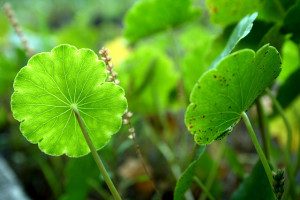
Dollarweed has its stem in the middle.
Allergic reactions. While a teacher can guarantee that a particular species is edible they cannot control for individual allergic reactions. We now have far more allergic people than half a century ago. The rate was about 3% in 1960 and 7% in 2018. Some think that has been caused by over-protective parents and no child ever unsupervised. We also know kids raised on farms have less allergies than most kids supporting the so- called hygiene hypothesis. When I was young no one ever heard of a peanut allergy or the like. As plants are chemical factories one can expect some people to have an allergic reaction to them. Among wild plants two sometimes produce a mild allergic reaction, Cucumber Weed and Epazote. Pawpaws carry a huge warning because they can cause a rare anaphylactic shock which is a severe allergic reaction. In a class this past week a fellow had an itchy throat reaction to Hydrocotyle bonariensis, our local common dollar weed. It wasn’t a severe reaction and all is well but it is one to be mindful of.
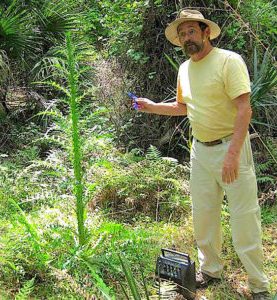
Foraging classes are held rain or shine, heat or cold. Photo by Nermina Krenata
Foraging classes: On this holiday weekend I have one class, Saturday, in Winter Park. It’s plant-rich location and a good time of year to go treasure hunting.
Saturday, May 8th, Mead Garden: 1500 S. Denning Dr., Winter Park, FL 32789. 9 a.m. to noon. Meet by the bathrooms. The entrance to Mead is on Denning not Pennsylvania. Some GPS get it wrong.
Saturday, May 15th, Eagle Park Lake, 1800 Keene Road, Largo, FL 33771. 9 to noon. Meet at the pavilion near the dog park.
Sunday, May 16th, Spruce Creek Park, 6250 Ridgewood Ave. Port Orange, 32127. 9 a.m. to noon, meet at the pavilion.
Saturday, May 22th, George LeStrange Preserve, 4911 Ralls Road, Fort Pierce, FL, 34981. 9 a.m. to noon, meet at the parking lot.
Sunday, May 23th, Wickham Park: 2500 Parkway Drive, Melbourne, FL 32935-2335. Meet at the “dog park” inside the park, 9 a.m. to noon.
For more class information, to sign up or prepay, go here.
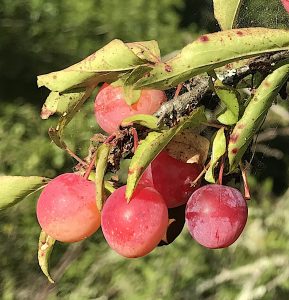
Wild Plums can be as sweet as cultivated plums. Photo by Green Deane
It was a “Prunus“ foraging week. While rummaging around our usual class location we saw Chickasaw Plums. They are just beginning to ripen and should be around for about six weeks. The Chickasaw Plums were not completely ripe but give them a week or two. Black Cherries are also ripening but are often more difficult to find because the birds also like them. Cherries and plums are in the same genus, Prunus, so it’s not surprising they are ripening at about the same time. Also setting fruit are the Flatwood Plums but they are different story and are included in my related article. I have a video on the Chickasaw plum here, Black Cherry here. To read about the Black Cherry go here, the Chickasaw Plum, here. Completely unrelated Tallow Plums are blossoming.
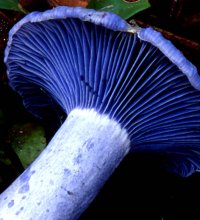
Lactarius indigo mushrooms are difficult to misidentify.
It’s been a strange week for edible wild mushrooms. Ringless Honey Mushrooms favor the fall but the right weather conditions in the spring — May specificially — can cause a minor occurrence of them. This this week there were sporadic reports of said about the South. I have even seem them on a Banyan in West Palm Beach in July. I saw five agung Lactarius indigo in Venice, Fl., this week, quite out of season. It is indeed a pretty mushroom and edible though its texture can be a tad grainy. With rains between now and the end of the month the summer mushroom season should get a good start. Hopefully by mid-June the Orlando Mushroom Group (OMG!) can have a forage.
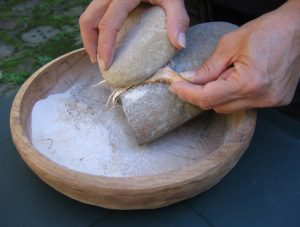
No plant produces more starch per acre than cattails.
If you were starving and came upon a patch of cattails (blossoming now) you would have great cause for celebration. You have found food and water. You will survive. But if you are not starving and do not have all the time in the inter-connected world you just might find cattails highly overrated. It is true that no plant can produce more starch per acre than cattails, about 3.5 tons under cultivation. And it can produce a lot of starch economically if you can mechanize the extraction. But hand extraction is time- consuming and labor intensive. It is also wet, smelly work all of which can be worsened significantly by harvesting in either cold or buggy weather. So yes, cattails are food but the time demand is such that harvesting food has to be your prime occupation. A similar argument can be made for kudzu. The roots do have edible starch but it takes a gargantuan amount of work to get the starch out, literally hours of steady pounding. It is not a calorie positive activity. It moves you closer to starvation. But, mechanize the process with some hammers run by falling water — or hammers run by a horse fed on an endless supply of grass — and kudzu becomes a reliable calorie-positive food. You can see my video on cattails here. I also have an article on Finding Caloric Staples with links to relevant videos.

Green Deane videos are now available on a USB.
150-video USB would be a good spring present and is now $99. My nine-DVD set of 135 videos has been phased out. The USB videos are the same videos I have on You Tube. Some people like to have their own copy. The USB videos have to be copied to your computer to play. If you want to order the USB go to the DVD/USB order button on the top right of this page. That will take you to an order form. I’d like to thank all of you who ordered the DVD set over the years which required me to burn over 5,000 DVDs individually.

Green Deane Forum
Want to identify a plant? Perhaps you’re looking for a foraging reference? You might have a UFO, an Unidentified Flowering Object, you want identified. On the Green Deane Forum we — including Green Deane and others from around the world — chat about foraging all year. And it’s not just about warm-weather plants or just North American flora. Many nations share common weeds so there’s a lot to talk. There’s also more than weeds. The reference section has information for foraging around the world. There are also articles on food preservation, and forgotten skills from making bows to fermenting food.
Your donations to upgrade the EatTheWeeds website and fund a book were appreciated. A book manuscript has been turned it. It had 424 articles, 1325 plants and a third of a million words. What it will be when the publisher is done with it next year is unknown. It will be published in the spring of 2023. Writing it took a significant chunk of time out of my life from which I have still not recovered. (Many things got put off.) The next phase is to update all the content on the website between now and publication date. Also note as it states above the 135-video DVD set has been phased out for 150-video USB. Times and formats change. Which reminds me I need to revisit many plants and make some new videos.
This is weekly newsletter #456. If you want to subscribe to this free newsletter you can find the sign-up form in the menu at the top of the page.
To donate to the Green Deane Newsletter click here.


I would like to subscribe to your newsletter and hope to join your foraging class.
Done.
HEY ole buddy, i was doing reasearch and came across walking onions – i feel this is a wonderful survival plant the onions develop on the top and walk year after year as the drop. i will send you some when i get them!!